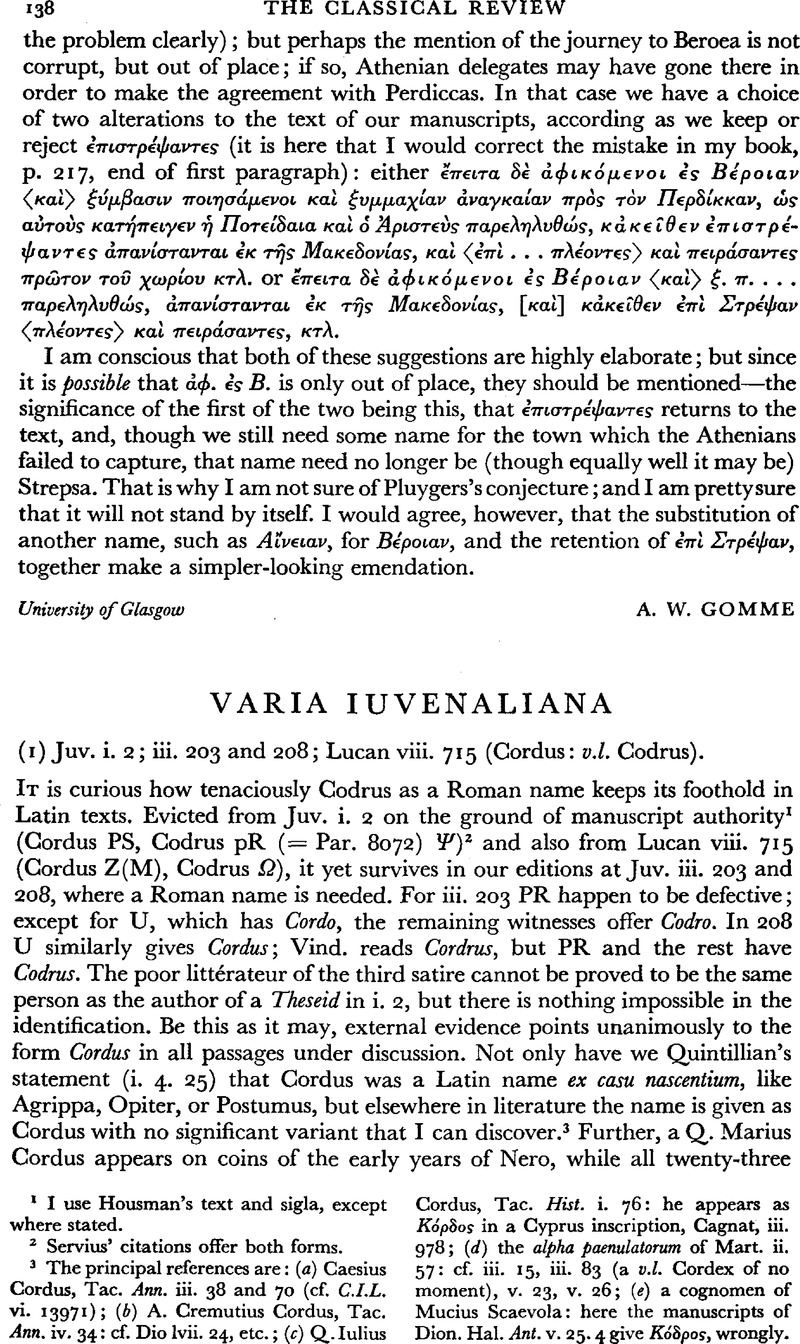No CrossRef data available.
Article contents
Varia Iuvenaliana
Published online by Cambridge University Press: 13 February 2009
Abstract

- Type
- Review Article
- Information
- Copyright
- Copyright © The Classical Association 1951
References
page 138 note 1 I use Housman's text and sigla, except where stated.
page 138 note 2 Servius' citations offer both forms.
page 138 note 3 The principal references are: (a) Caesius Cordus, Tac. Ann. iii. 38 and 70 (cf. C.I.L. vi. 13971); (b) A. Cremutius Cordus, Tac. Ann. iv. 34: cf. Dio lvii. 24, etc.; (c) Q. Iulius Cordus, Tac. Hist. i. 76: he appears as Kόδρoς in a Cyprus inscription, Cagnat, iii. 978; (d) the alpha paenulatorum of Mart. 57: cf. iii. 15, iii. 83 (a v.l. Cordex of no moment), v. 23, v. 26; (e) a cognomen of Mucius Scaevola: here the manuscripts of Dion. Hal. Ant. v. 25.4 give Kόδρoς, wrongly.
page 139 note 1 So, e.g., Q. Manilius Cordus in C.I.L. xi. 707 (= I.L.S. 2705) and M. Granius Cordus in ix. 2353 (= I.L.S. 6513). The spelling Gordus in xiii. 1833 is not for our purpose significant.
page 139 note 2 As by Skutsch in R.E. Suppl. i, col. 324.
page 139 note 3 Cf. Juv. vii. 154 (crambre P Arou).
page 139 note 4 This has happened in P in Juv. i. 2; see Beer, Spicilegium, p. 22 and facsimile.
page 140 note 1 Cf. (for Sat.i only) in P 35, 70, 126, 159; in Ψ 52, 86, 106, etc.
page 140 note 2 For the confusion of a and u in early minuscule (or half-uncial for that matter) see, e.g., Lindsay, W. M., Latin Textual Emendation, p. 83Google Scholar.
page 140 note 3 He had some excuse in that this idiom is abnormal in prose but legitimate in verse; Virg. Aen. iv. 339, etc.
page 140 note 4 According to U. Knoche, Gnomon, ix. 249, neque here is suspect anyway, for Juv. seems to have written nec except in the phrase neque enim. One may well ask why this should have been so, but assuming that this is cor- rect, it might be well to write nec in n o (on the authority of U Vind.) as Bücheler did in his edition of 1886.
page 141 note 1 ‘Molossische und baccheische Wort-formen’, in Abhandlungen der sächsischen Akademie, phil.-hist. Klasse xxxvii. 1, especi-ally p. 133.
page 141 note 2 The references for Cyrene are: (a) long first syllable, Ar. Thesm. 98, Apoll. Rhod. ii. 500, Callim. iii. 206; (b) short, Hes.fr. 128 Rz., Pindar (8 times), Callim. ii. 73 and 94. In Latin it is long four times in Virg. Georg. iv, but short in Cat. 7. 4 and Catalepton 9. 61.
page 141 note 3 Quoted by Mayor ad loc. (p. 276).
page 141 note 4 His examples mostly show the perfect subjunctive, but Cic. Off. iii. 54 is a safe instance of the present (vendat aedes = fac eum vendere).
page 141 note 5 See, e.g. for Plautus, F. W. Hall in C.Q. xx. 20 ff.


